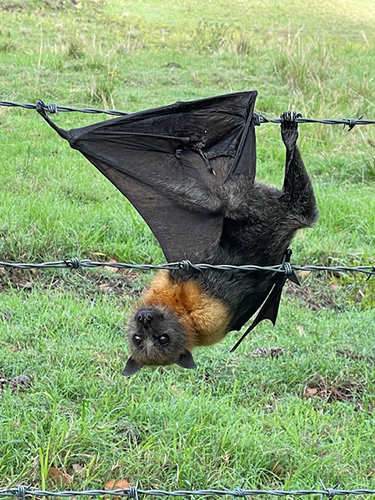LET'S NOT RUBBISH OUR WILDLIFE
A carelessly tossed bottle
We often pass by discarded waste without a second thought, not realising the hidden dangers it poses. It’s not just an eyesore; it’s a perilous trap for the local wildlife. The consequences of our carelessness are far-reaching, transforming innocent curiosity into a life-threatening ordeal for our furry and feathered friends.
Consider the shards of glass from a carelessly tossed bottle, now shattered by the elements. These jagged pieces become almost invisible traps set against the earthy tones of the forest floor. An unsuspecting wallaby, bounding through the underbrush, could easily slice its delicate paws on this man-made menace. Unlike us, these creatures can’t dial up a doctor for a stitch or a shot of antibiotics. For them, a simple cut can spiral into a life-threatening infection, or leave them hobbled, struggling to fend for themselves in the wild.
But this bleak picture need not be our reality. With a flicker of consideration for the other souls with whom we share this blue and green canvas, we can change the narrative. By taking responsibility for our environment—picking up after ourselves and even going a step further to clean up after those who’ve neglected to do so—we can safeguard our wildlife from harm.
Let’s not just coexist with our environment; let’s nurture it, protect it, and treasure the diverse life it supports. By doing so, we not only preserve the beauty and health of our natural world but also ensure that the stories of our unique Australian wildlife continue to enchant generations to come. The choice is in our hands; let’s make it the right one.
A discarded drink can.
In the quiet rustle of the underbrush, a curious snake flickers its tongue, tasting the air. It’s a world rich with scents and secrets, a mosaic of life where every creature plays a part. But sometimes, this delicate balance is disrupted by the most mundane of human leftovers: a discarded drink can.
Glinting in the dappled sunlight, the can is an intruder here. Yet to the snake, it’s an enigma, an unexplored cavern that beckons with potential shelter or sustenance. Driven by instinct, the snake weaves its way toward the can.
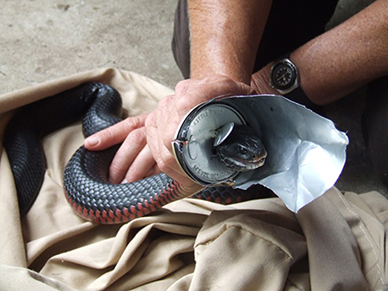
As it probes the opening, the cool metal against its scales is an unfamiliar sensation. The snake’s head slips inside the can with ease, driven by curiosity. But in a heart-wrenching twist of fate, this exploration turns into a trap. The scales that allow the snake to glide so effortlessly through the grass now betray it; designed to lay flat and smooth in one direction, they catch on the can’s rim, making retreat impossible.
The snake is pinned, its neck ensnared by the very body that usually spells its freedom. It’s a silent struggle that goes unseen, a battle for life against a piece of thoughtless litter. This snake is just one of countless wildlife victims that encounter human refuse in their natural habitats, a stark reminder of how our actions can unwittingly cast long shadows on the natural world.
This scene is not just a tale of danger, but a call to awareness and action. Each piece of litter has a story, and sometimes that story ends with a wild creature’s plight. By disposing of our waste responsibly, we can rewrite these tales, turning them into stories of coexistence and respect for the intricate web of life that thrives in the Australian bush.
Ring seals- tamper evident bands
As the sun stretches its golden fingers across the Australian landscape, the air is filled with the warbling calls of magpies. These iconic birds, with their striking black and white plumage, are as much a part of our mornings as a hot cup of tea. Now, picture one of these beautiful creatures, its neck ensnared by a seemingly innocent piece of plastic – a ring seal from a bottle that was carelessly discarded. This small loop, barely noticeable in our daily lives, can become a noose for wildlife, a silent predator that never needs to eat but can still take a life.
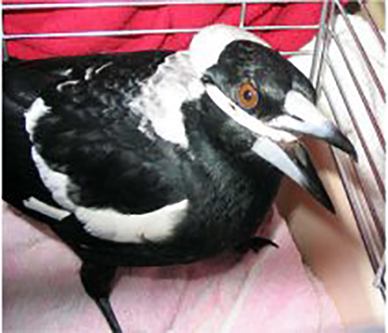
The Magpie in the photograph you’re looking at was one of the fortunate ones. It was discovered in time by a kind-hearted soul who saw the struggle and stepped in to help. With gentle hands and a pair of scissors, they snipped the plastic ring, setting the bird free from what could have been a slow and painful end. The relief in the bird’s eyes was palpable as it took to the sky once more, its song a little stronger, as if to say thank you.
But for every story of rescue, there are countless others that go untold. Many creatures, not just birds but Turtles, Platypus, and other wildlife, encounter these plastic traps and aren’t found in time. They suffer in silence, hidden away from our sight, their songs and movements stilled forever.
We have the power to change this narrative. It’s as simple as altering our habits ever so slightly. Before we throw away a plastic milk bottle, peanut butter jar, a cordial container or any container, take a moment to look for the plastic ring seal. Take a pair of scissors and cut through the plastic loop. It’s a small act, but it can mean the difference between life and death for the creatures we share our environment with.
By doing this, we’re not just preventing potential harm; we’re actively participating in the protection of our natural world. We’re ensuring that the symphony of wildlife that makes our country so unique continues to play on. So next time you are about to throw away a container of any kind, check for a ring seal, remember the magpie and make that one simple cut. It’s a gesture of care, a promise to our wildlife that we’re looking out for them, ensuring that their future, much like ours, is free to soar.
Plastic bags
In the quiet rustle of the eucalyptus leaves and the gentle lapping of the creek’s water, there lurks a silent predator, one not born of teeth and claws, but of our own making. Plastic bags, those seemingly innocuous carriers of our daily conveniences, have become the scourge of the natural world, littering the landscape like unwanted ghosts of consumerism. They cling to the branches and fence posts along country roads, dance in the wind like spectres, and eventually find their way into the serene waterways that are the lifeblood of the Australian bush.
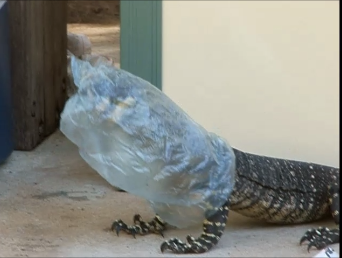
Here, in these vital aquatic arteries, the plastic bags begin their most destructive journey. They ensnare the curious and the innocent — the Turtles, with their age-old wisdom, and the playful Platypus, unique to our land — trapping and constricting them in a death grip that is as cruel as it is preventable. Farther afield, in the vast blue expanse of the ocean, these bags float like jellyfish, deceptive in their appearance, causing havoc amongst the diverse marine life. They are consumed by fish, strangle Seabirds, and suffocate the majestic marine mammals that grace our waters, slowly and painfully compromising their existence in ways that are heartbreaking to witness.
Amidst this bleak tableau, a story of hope emerges. A Goanna, a proud and ancient lizard that has walked this land for countless generations, found itself in a battle for its life against this modern menace. The plastic, a noose around its powerful body, threatened to cut short its journey through the bush. But fortune smiled upon this creature; it was spotted just in time by caring individuals, those guardians of the wild who dedicate their lives to protecting our natural heritage. With gentle hands and kind hearts, they freed the Goanna from its plastic prison, allowing it to return to the wild, a symbol of resilience in the face of adversity.
This Goanna’s tale is a poignant reminder of the impact our daily choices have on the world around us. It is a call to action, a plea for mindfulness in how we live and consume. By reducing our reliance on plastics, opting for reusable alternatives, and disposing of waste responsibly, we can all play a part in safeguarding the future of Australia’s unique and precious wildlife. Let us take inspiration from the Goanna’s lucky escape and work together to ensure that such stories of survival become the norm, not the exception, in the ongoing narrative of our environment.
Discarded fishing line & hook
Beneath the golden Australian sun, our waterways glisten like jewels scattered across the landscape. These aquatic havens are not only a source of life for the wildlife but also a playground for human leisure activities, such as fishing. Yet, amidst this serene backdrop, a silent peril often goes unnoticed. Discarded fishing line, the ghost of a fisher’s pastime, becomes a sinister snare for the unsuspecting creatures that call these waters home.
Imagine a majestic Sea eagle soaring above the coastline, its sharp eyes scanning the depths for a hint of silver. In a flash, it dives, only to emerge with a tangled mess of fishing line that now binds its powerful talons.
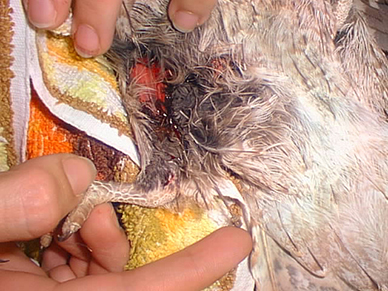
Or picture a curious Platypus, that unique jewel of the Australian waterways, whose playful foraging is cut short as it becomes ensnared by a cruel hook, an alien invader in its tranquil world.
These are not mere flights of fancy but heart-wrenching realities for many birds, turtles, and Platypus. Fishing hooks, those small, seemingly innocuous metal curves, can embed themselves with ease into the soft flesh of a creature’s foot, body, or mouth. The pain and distress caused by such entrapment can lead to dire consequences, hindering their ability to forage, escape predators, or simply survive.
Yet, hope is not lost. Each one of us holds the power to turn the tide on this environmental challenge. When you find yourself in the embrace of nature, by a riverbank or on a sandy shore, be the guardian of these wild spaces. Keep your eyes peeled for the remnants of fishing adventures – the lines and hooks left behind, lurking in the shadows of rocks and reeds.
With every piece of discarded line you gather and dispose of responsibly, you become a hero in the eyes of the wildlife. Your actions ripple through the ecosystem, preserving the delicate balance of life. It is a simple act, yet its impact is profound.
A simple piece of unwanted fishing line, dropped without a second thought, can become a weapon against the innocent wildlife that forage in the underbrush and along the water’s edge.
Imagine the plight of a bird, like the magpie with its striking black and white plumage and melodic song, as it hops about in search of a meal. In one fateful moment, it finds its feet ensnared, bound together by the invisible, unyielding grip of discarded fishing line. The more it struggles, the tighter the noose becomes, cutting off blood flow, threatening to sever the very limbs it relies upon for survival.
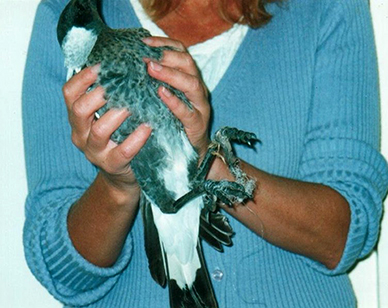
But not every story ends in tragedy. Consider the magpie mentioned, its plight noticed by a compassionate soul who saw the struggle and took action. This magpie was one of the fortunate ones, rescued from a grim fate and given a second chance at life. Its feet, once bound, now free, serve as a reminder of both the fragility and resilience of nature.
This tale serves as a call to action for all who enjoy casting a line. When you pack up your gear, take a moment to look around. Your vigilance could be the lifeline that wildlife desperately needs. By picking up and properly disposing of any discarded fishing line you encounter, you contribute to the preservation of our natural heritage.
So, let us cast a wider net of responsibility, safeguarding the intricate web of life that thrives in our forests, plains, and coastlines. Each of us can make a difference, ensuring that the only lines that remain are those that connect us to the beauty of the world around us, not those that endanger it. Let’s keep the bushland chorus singing, the forest floor bustling, and our waters pure, for the magpies and all their wild kin.
Orchard netting
In the sun-scorched yards and rustic sheds of Australia, a silent peril often lurks – the remnants of orchard netting, casually discarded or haphazardly thrown over fruit trees and vegetable patches in a bid to shield the tender plants from hungry wildlife. Yet, this seemingly innocent act of plant protection can transform into a death trap for the very creatures it aims to deter.
Imagine a delicate bat, or a beautiful dove, wings outstretched, ensnared in the unforgiving embrace of this synthetic web. The struggle for freedom only tightens its grip, leading to a heart-wrenching outcome of constriction, dehydration, and starvation. The plight of these creatures, caught in a man-made snare, is a stark reminder of the unintended consequences our actions can have on the natural world.
It is a scene that tugs at the heartstrings and calls us to action. We must be vigilant and conscientious stewards of our environment. It is our duty to ensure that the netting, once serving its purpose, does not become a forgotten relic of our negligence. We must remove it responsibly from our land, ensuring that it no longer poses a threat to the unsuspecting wildlife that wanders through our backyards.
Let us band together, friends and neighbours, to spread the word and encourage responsible netting practices. Opt for wildlife-friendly alternatives, such as using white netting with a mesh size less than 5mm, which is less likely to entangle birds and other animals. Secure it tightly, so it doesn’t sag and become an accidental trap.
By taking these simple steps, we not only protect our cherished plants but also safeguard the diverse and precious fauna that share this sunburnt country with us. Together, let’s weave a narrative of coexistence and compassion, ensuring that our gardens are havens for all life, not hazards.
Barbed wire versus native wildlife
In the quiet of the Australian bush, a silent yet deadly menace lurks, not of flesh and blood, but of cold, unyielding steel. Imagine, if you will, a world where the very skies and trees that offer life and refuge to our native creatures also conceal a trap that can bring about pain and despair. This is the reality for many of our winged and arboreal companions, the unsuspecting victims of barbed wire.
